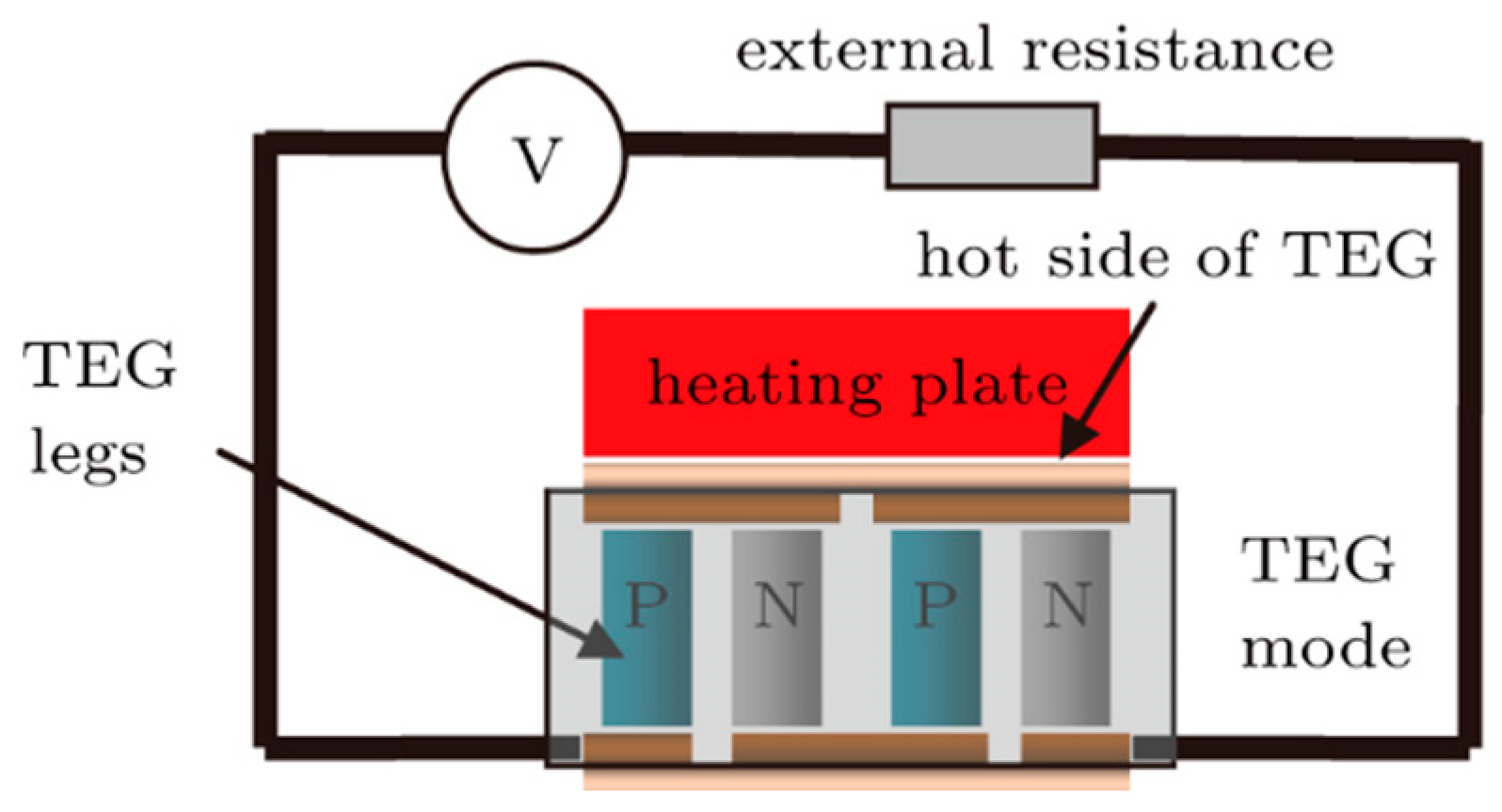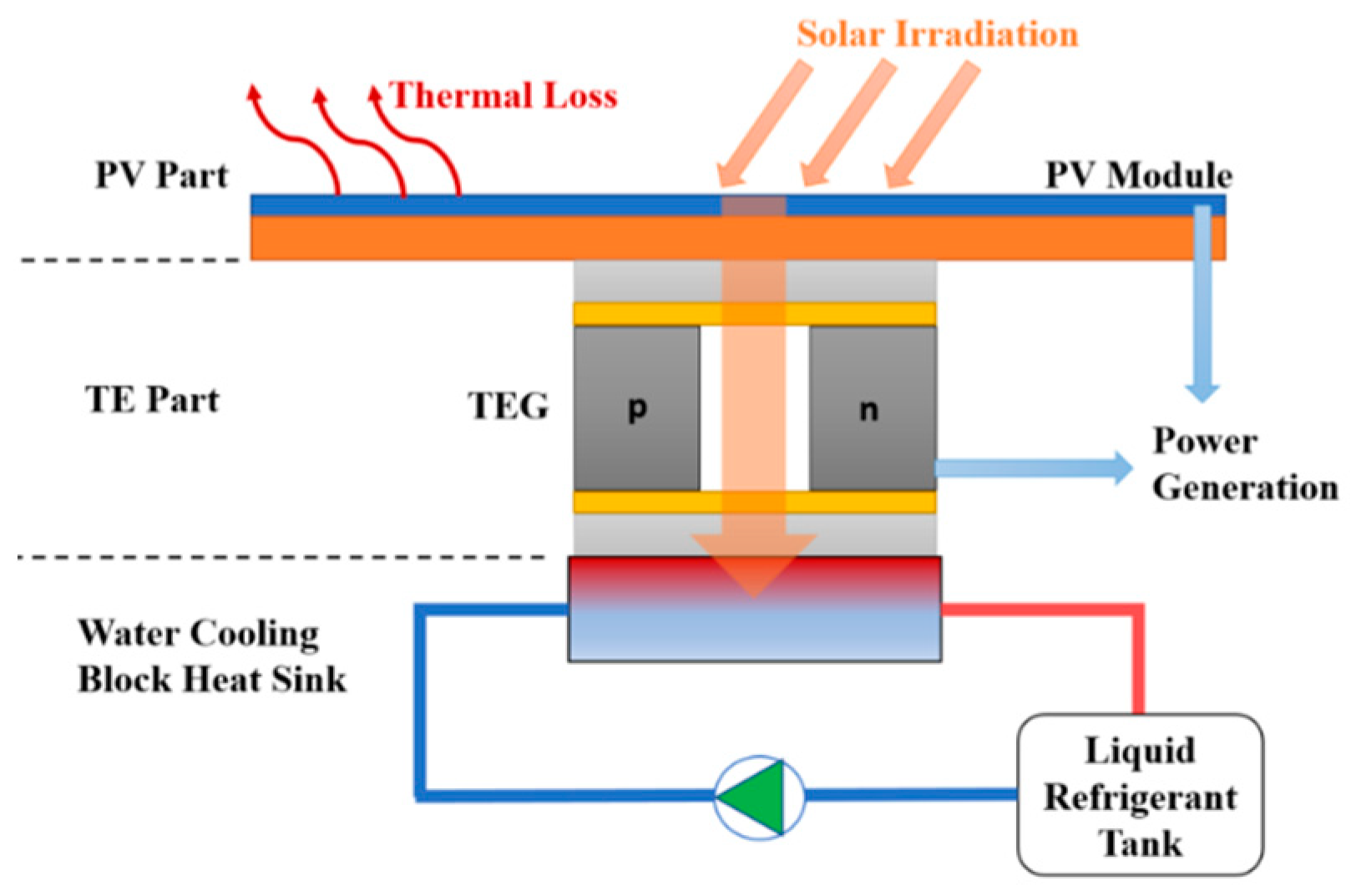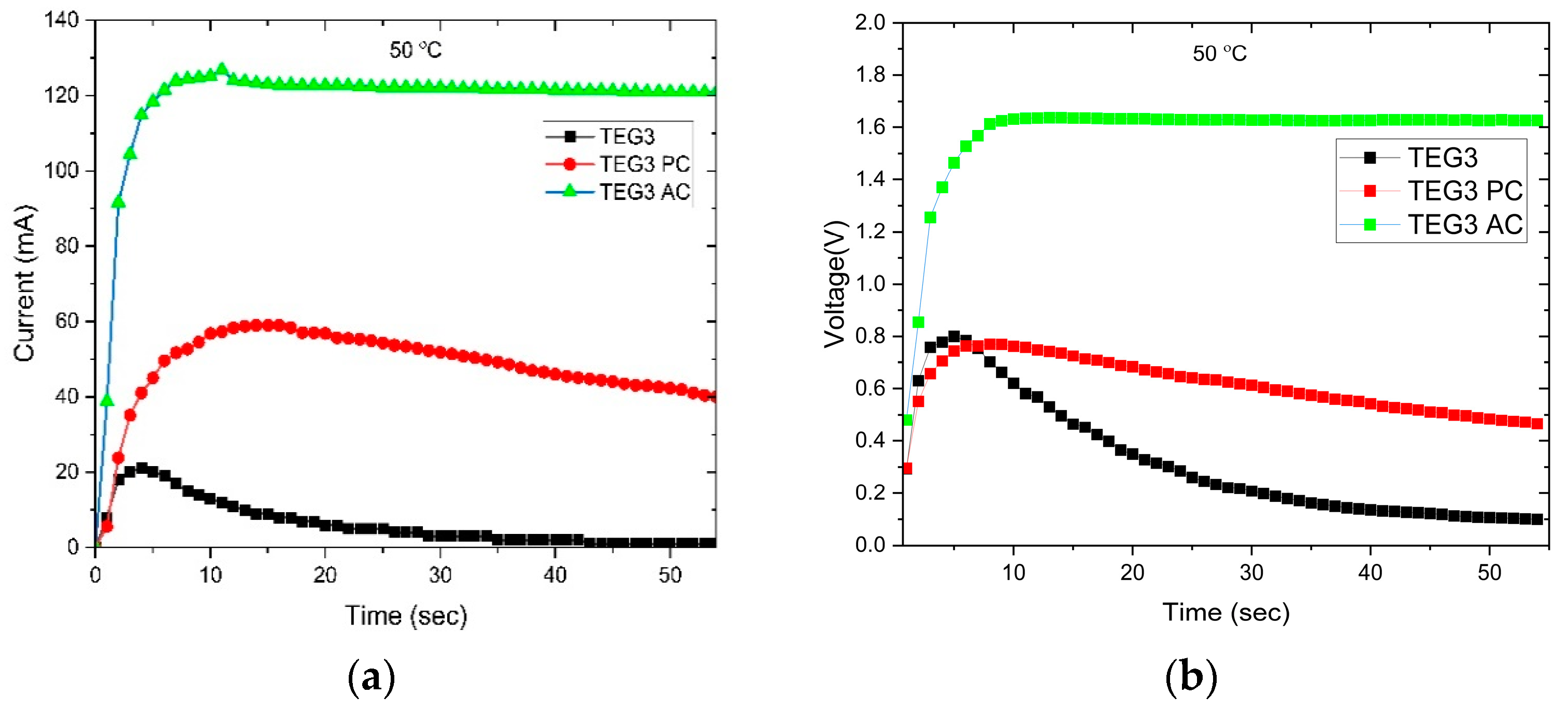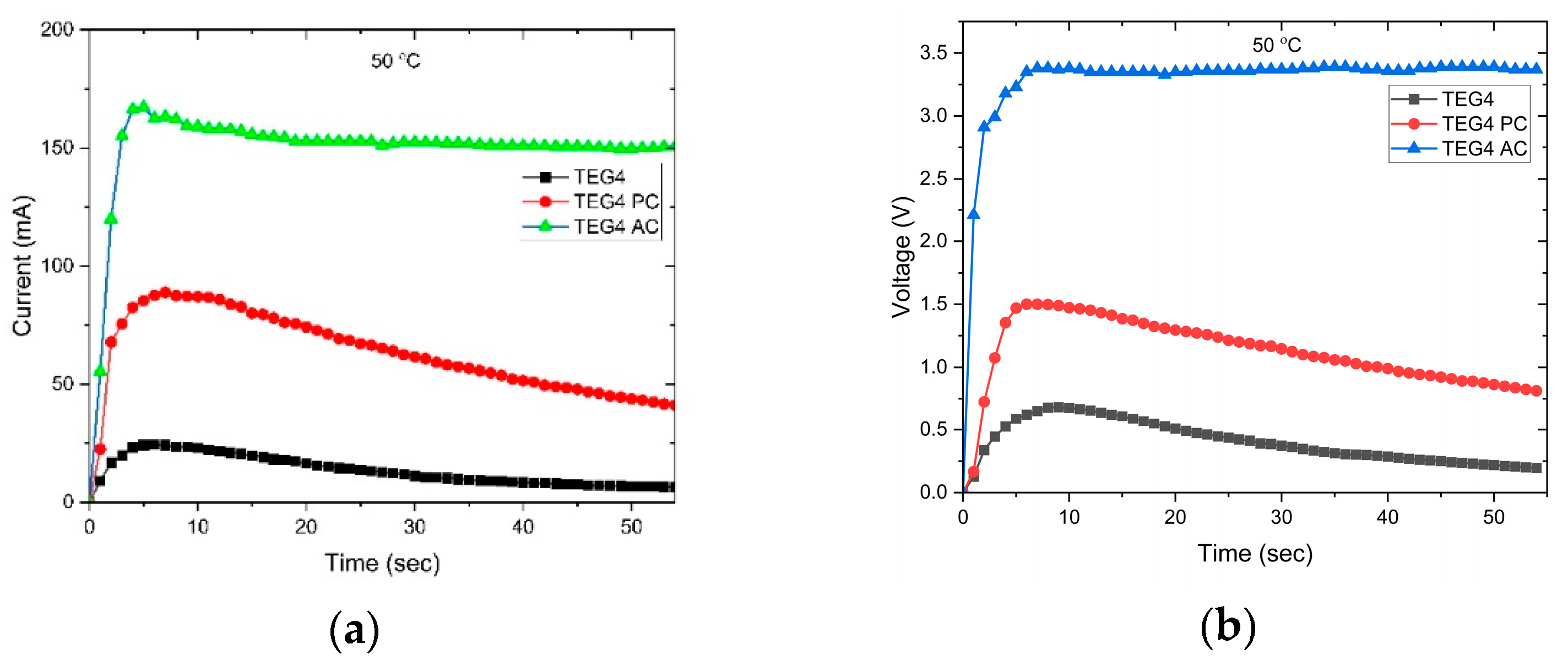Efficiency Enhancement in Photovoltaic–Thermoelectric Hybrid Systems through Cooling Strategies
Abstract
:1. Introduction
2. Materials and Methods
3. Results and Discussion
4. Conclusions
Author Contributions
Funding
Data Availability Statement
Conflicts of Interest
Abbreviations
| PV | Photovoltaic |
| TE | Thermoelectric |
| TEG | Thermoelectric Generator |
| PV-TE | Photovoltaic–Thermoelectric |
| STC | Standard Test Conditions |
| IEC | International Electrotechnical Commission |
| EN | European Norms |
| CO2 | Carbon Dioxide |
| °C | Celsius |
| RPV | Photovoltaic Resistance |
| Th | Hot-Side Temperature |
| TC | Cold-Side Temperature |
| RTEG | Resistance of TEG |
| Ta | Ambient Temperature |
| STC | Standard Test Conditions |
| PC | Passive Cooling |
| P | Positive Material |
| N | Negative Material |
| AC | Active Cooling |
| nAC | Nanofluid Active Cooling |
| Al2O3 | Aluminum Oxide |
| Egap | Bandgap Energy |
| ISO | International Organization for Standardization |
References
- National Renewable Energy Laboratory. Available online: http://www.nrel.gov/ncpv/images/efficiency_chart.png (accessed on 13 September 2023).
- Solar Photovoltaic Panel Prices vs. Cumulative Capacity. Available online: https://ourworldindata.org/ (accessed on 29 September 2023).
- Madeti, S.R.; Singh, S.N. Monitoring system for photovoltaic plants: A review. Renew. Sustain. Energy Rev. 2017, 67, 1180–1207. [Google Scholar] [CrossRef]
- Bilen, K.; Erdoğan, İ. Effects of cooling on performance of photovoltaic/thermal (PV/T) solar panels: A comprehensive review. Sol. Energy 2023, 262, 111829. [Google Scholar] [CrossRef]
- Dada, M.; Popoola, P. Recent advances in solar photovoltaic materials and systems for energy storage applications: A review. Beni-Suef Univ. J. Basic Appl. Sci. 2023, 12, 66. [Google Scholar] [CrossRef]
- Lu, Z.; Huang, Y.; Zhao, Y. Performance investigation of a concentrated photovoltaic-thermoelectric hybrid system for electricity and cooling production. Appl. Therm. Eng. 2023, 231, 120916. [Google Scholar] [CrossRef]
- Zhao, Q.; Zhang, H.; Hu, Z.; Hou, S. Achieving a broad-spectrum photovoltaic system by hybridizing a two-stage thermoelectric generator. Energy Convers. Manag. 2020, 211, 112778. [Google Scholar] [CrossRef]
- Cristaldi, L.; Faifer, M.; Rossi, M.; Toscani, S. An improved model based maximum power point tracker for photovoltaic panels. IEEE Trans. Instrum. Meas. 2014, 63, 63–71. [Google Scholar] [CrossRef]
- Xuan, X.; Li, D. Optimization of a combined thermionic–thermoelectric generator. J. Power Sources 2003, 115, 167–170. [Google Scholar] [CrossRef]
- Zhang, Z.; Li, W.; Kan, J. Behavior of a thermoelectric power generation device based on solar irradiation and the earth’s surface-air temperature difference. Energy Convers. Manag. 2015, 97, 178–187. [Google Scholar] [CrossRef]
- Dallan, B.; Schumann, J.; Lesage, F.J. Performance evaluation of a photoelectric–thermoelectric cogeneration hybrid system. Solar Energy 2015, 118, 276–285. [Google Scholar] [CrossRef]
- Lin, J.; Liao, T.; Lin, B. Performance analysis and load matching of a photovoltaic–thermoelectric hybrid system. Energy Convers. Manag. 2015, 105, 891–899. [Google Scholar] [CrossRef]
- Cui, T.; Xuan, Y. Design of a novel concentrating photovoltaic–thermoelectric system incorporated with phase change materials. Energy Convers. Manag. 2016, 112, 49–60. [Google Scholar] [CrossRef]
- Chow, T.T.; Li, Q. A review on photovoltaic/thermal hybrid solar technology. Appl. Energy 2010, 87, 365–379. [Google Scholar] [CrossRef]
- Li, Y.; Witharana, S.; Cao, H.; Lasfargues, M.; Huang, Y.; Ding, Y. Wide spectrum solar energy harvesting through an integrated photovoltaic and thermoelectric system. Particuology 2014, 15, 39–44. [Google Scholar] [CrossRef]
- Narducci, D.; Lorenzi, B. Challenges and perspectives in tandem thermoelectricphotovoltaic solar energy conversion. IEEE Trans. Nanotechnol. 2016, 15, 348–355. [Google Scholar] [CrossRef]
- Tohidi, F.; Holagh, S.G.; Chitsaz, A. Thermoelectric Generators: A comprehensive review of characteristics and applications. Appl. Therm. Eng. 2022, 201, 117793. [Google Scholar] [CrossRef]
- Champier, D. Thermoelectric generators: A review of applications. Energy Convers. Manag. 2017, 140, 167–181. [Google Scholar] [CrossRef]
- He, W.; Zhang, G.; Zhang, X.; Ji, J.; Li, G.; Zhao, X. Recent development and application of thermoelectric generator and cooler. Appl. Energy 2015, 143, 1–25. [Google Scholar] [CrossRef]
- Kraemer, D.; McEnaney, K.; Chiesa, M.; Chen, G. Modeling and optimization of solar thermoelectric generators for terrestrial applications. Sol. Energy 2012, 86, 1338–1350. [Google Scholar] [CrossRef]
- Deng, Y.; Zhu, W.; Wang, Y.; Shi, Y. Enhanced performance of solar-driven photovoltaic–thermoelectric hybrid system in an integrated design. Sol. Energy 2013, 88, 182–191. [Google Scholar] [CrossRef]
- Zhang, J.; Xuan, Y.; Yang, L. Performance estimation of photovoltaic thermoelectric hybrid systems. Energy 2014, 78, 895–903. [Google Scholar] [CrossRef]
- Dewangan, D.; Ekka, J.P.; Arjunan, T.V. Solar photovoltaic thermal system: A comprehensive review on recent design and development, applications and future prospects in research. Int. J. Ambient. Energy 2022, 43, 7247–7271. [Google Scholar] [CrossRef]
- Lee, J.; Cho, K.; Park, Y.; Park, S.; Song, H.E.; Kim, S. Performance Enhancement of Hybrid Energy Devices Using Cooling Patches. Int. J. Photoenergy 2022, 2022, 364240. [Google Scholar] [CrossRef]
- Tang, J.; Ni, H.; Peng, R.L.; Wang, N.; Zuo, L. A review on energy conversion using hybrid photovoltaic and thermoelectric systems. J. Power Sources 2023, 562, 232785. [Google Scholar] [CrossRef]
- Kohan, H.F.; Eslami, M.; Jafarpur, K. Thermal influence of thermoelectric modules on performance of hybrid PV-TEG systems: Effects of TEG type, arrangement and working condition. Int. Commun. Heat Mass Transf. 2023, 147, 106969. [Google Scholar] [CrossRef]
- Luo, D.; Wu, Z.; Yan, Y.; Cao, J.; Yang, X.; Zhao, Y.; Cao, B. Performance investigation and design optimization of a battery thermal management system with thermoelectric coolers and phase change materials. J. Clean. Prod. 2024, 434, 139834. [Google Scholar] [CrossRef]
- Yang, B.; Wang, J.; Su, S.; Li, Y.; Wu, P.; Yang, Z.; Li, J. Mismatch losses mitigation of PV-TEG hybrid system via improved RIME algorithm: Design and hardware validation. J. Clean. Prod. 2024, 434, 139957. [Google Scholar] [CrossRef]
- Khanalizadeh, A.; Astaraei, F.R.; Heyhat, M.M.; Rad, M.A.V. Experimental investigation of a PV/T system containing a TEG section between water-based heat exchanger and air-based heat sink. Therm. Sci. Eng. Prog. 2023, 42, 101909. [Google Scholar] [CrossRef]
- Gao, Y.; Wu, D.; Dai, Z.; Wang, C.; Zhu, L.; Zhang, J.; Xu, G.; Zhang, X. A passive evaporative cooling strategy to enhance the electricity production of hybrid PV-STEG system. Appl. Energy 2023, 349, 121689. [Google Scholar] [CrossRef]
- Attivissimo, F.; Di Nisio, A. Feasibility of a photovoltaicthermoelectric generator: Performance analysis and simulation results. IEEE Trans. Instrum. Meas. 2015, 64, 1158–1169. [Google Scholar] [CrossRef]
- Khan, N.M.; Ahmed, A.; Haider, S.K.; Zafar, M.H.; Mansoor, M.; Akhtar, N. Hybrid General Regression NN Model for Efficient Operation of Centralized TEG System under Non-Uniform Thermal Gradients. Electronics 2023, 12, 1688. [Google Scholar] [CrossRef]
- Herez, A.; El Hage, H.; Lemenand, T.; Ramadan, M.; Khaled, M. Review on photovoltaic/thermal hybrid solar collectors: Classifications, applications and new systems. Sol. Energy 2020, 207, 1321–1347. [Google Scholar] [CrossRef]
- Li, G.; Shittu, S.; Zhou, K.; Zhao, X.; Ma, X. Preliminary experiment on a novel photovoltaic-thermoelectric system in summer. Energy 2019, 188, 116041. [Google Scholar] [CrossRef]
- Wen, X.; Ji, J.; Li, Z. Evaluation of the phase change material in regulating all-day electrical performance in the PV-MCHP-TE system in winter. Energy 2023, 263, 125919. [Google Scholar] [CrossRef]
- Enayatollahi, R.; Farid, M.M. An integrated cooling mechanism for photovoltaic systems. Numer. Heat Transf. Part A Appl. 2023, 1–12. [Google Scholar] [CrossRef]
- Abou Akrouch, M.; Chahine, K.; Faraj, J.; Hachem, F.; Castelain, C.; Khaled, M. Advancements in Cooling Techniques for Enhanced Efficiency of Solar Photovoltaic Panels: A Detailed Comprehensive Review and Innovative Classification. Energy Built Environ. 2023, in press. [CrossRef]
- Indira, S.S.; Vaithilingam, C.A.; Chong, K.K.; Saidur, R.; Faizal, M.; Abubakar, S.; Paiman, S. A review on various configurations of hybrid concentrator photovoltaic and thermoelectric generator system. Sol. Energy 2020, 201, 122–148. [Google Scholar] [CrossRef]
- Cotfas, D.T.; Cotfas, P.A.; Mahmoudinezhad, S.; Louzazni, M. Critical factors and parameters for hybrid photovoltaic-thermoelectric systems; review. Appl. Therm. Eng. 2022, 215, 118977. [Google Scholar] [CrossRef]
- Kumar, S.; Mandal, S.K.; Singh, P.K.; Mishra, S.K.; Das, A.K. Performance Analysis of a Thermoelectric Generation System with Different Flow Configurations. J. Electron. Mater. 2019, 48, 4607–4617. [Google Scholar] [CrossRef]
- Available online: https://www.energy.gov/sites/prod/files/2014/01/f7/pvmrw13_ps1_univljub_janovec.pdf (accessed on 27 December 2023).
- Nandihalli, N.; Liu, C.J.; Mori, T. Polymer based thermoelectric nanocomposite materials and devices: Fabrication and characteristics. Nano Energy 2020, 78, 105186. [Google Scholar] [CrossRef]
- Sundarraj, P.; Maity, D.; Roy, S.S.; Taylor, R.A. Recent advances in thermoelectric materials and solar thermoelectric generators—A critical review. RSC Adv. 2014, 87, 46860–46874. [Google Scholar] [CrossRef]
- Xu, X.; Zhou, S.; Meyers, M.M.; Sammakia, B.G.; Murray, B.T. Performance analysis of a combination system of concentrating photovoltaic/thermal collector and thermoelectric generators. J. Electron. Packag. 2014, 136, 41004–41010. [Google Scholar] [CrossRef]
- Haidar, J.G.; Ghogel, J.I. Waste heat recovery from the exhaust of low-power diesel engine using thermal electric generators. In Proceedings of the ICT2001. 20 International Conference on Thermoelectrics, Beijing, China, 8–11 June 2001; pp. 413–417. [Google Scholar] [CrossRef]
- ISO/IEC 17025; Testing and Calibration Laboratories. International Standards Organisation: Geneva, Switzerland, 2017. Available online: https://www.iso.org/ISO-IEC-17025-testing-and-calibration-laboratories.html (accessed on 13 September 2023).
- IEC 61215-1:2021; Terrestrial photovoltaic (PV) Modules—Design Qualification and Type Approval—Part 1: Test Requirements. International Electrotechnical Commission (IEC): Geneva, Switzerland, 2021. Available online: https://webstore.iec.ch/publication/61345 (accessed on 13 September 2023).
- Xu, Z.; Kleinstreuer, C. Concentration Photovoltaic–Thermal Energy Co-Generation System Using Nanofluids for Cooling and heating. Energy Convers. Manag. 2014, 87, 504–512. [Google Scholar] [CrossRef]
- Wu, Y.; Wu, S.; Xiao, L. Performance analysis of photovoltaic–thermoelectric hybrid system with and without glass cover. Energy Convers. Manag. 2015, 93, 151–159. [Google Scholar] [CrossRef]








| Name | Manufacturer | Thickness of TEG in mm | Thickness of Surface in mm | Thickness of PN Junction Area in mm | Model | TE Material | Plate Material |
|---|---|---|---|---|---|---|---|
| TEG1 | Hebei, Shanghai, China | 3.87 | 0.71 | 2.45 | TEC1-12706 | Bi2Te3 | Ceramic Al2O3 |
| TEG2 | Euroquartz, Shanghai, China | 3.71 | 0.73 | 2.25 | SP1848 27145 SA | Bi2Te3 | Ceramic Al2O3 |
| TEG3 | Kuongshun, Shenzhen, China | 3.77 | 0.71 | 2.35 | SP1848 27145 SA | Bi2Te3 | Ceramic Al2O3 |
| TEG4 | Adaptive, Leicestershire, UK | 3.59 | 0.89 | 1.81 | ETH-127-10-13-S-RS | Bi2Te3 | Ceramic Al2O3 |
| TEG5 | Marlow, Dallas, TX, USA | 3.9 | 0.7 | 2.5 | RC12 91826 | Bi2Te3 | Ceramic Al2O3 |
| TEG6 | TEC, Calgary, AB, Canada | 3.56 | 0.86 | 1.84 | TEG2-07025HT-SS | Bi2Te3 | Ceramic, graphite |
| TEG7 | TEC | 4.81 | 0.99 | 2.83 | TEG1-PB-12611 | Pb, Bi2Te3 | Ceramic, graphite |
| Product Test in 50 °C Ta | Power in W | Performance Increase |
|---|---|---|
| PV | 5.48 | |
| PV-TE TEG3 | 5.480107 | 0.00% |
| PV-TE TEG3 PC | 5.504732 | 0.45% |
| PV-TE TEG3 AC | 5.676746 | 3.59% |
| PV-TE TEG3 nAC | 5.682654 | 3.69% |
| Product Test in 50 °C Ta | Power in W | Performance Increase |
|---|---|---|
| PV | 5.48 | |
| PV-TE TEG4 | 5.480149 | 0.00% |
| PV-TE TEG4 PC | 5.503771 | 0.43% |
| PV-TE TEG4 AC | 5.987822 | 9.26% |
| PV-TE TEG4 nAC | 5.997978 | 9.45% |
Disclaimer/Publisher’s Note: The statements, opinions and data contained in all publications are solely those of the individual author(s) and contributor(s) and not of MDPI and/or the editor(s). MDPI and/or the editor(s) disclaim responsibility for any injury to people or property resulting from any ideas, methods, instructions or products referred to in the content. |
© 2024 by the authors. Licensee MDPI, Basel, Switzerland. This article is an open access article distributed under the terms and conditions of the Creative Commons Attribution (CC BY) license (https://creativecommons.org/licenses/by/4.0/).
Share and Cite
Bulat, S.; Büyükbicakci, E.; Erkovan, M. Efficiency Enhancement in Photovoltaic–Thermoelectric Hybrid Systems through Cooling Strategies. Energies 2024, 17, 430. https://doi.org/10.3390/en17020430
Bulat S, Büyükbicakci E, Erkovan M. Efficiency Enhancement in Photovoltaic–Thermoelectric Hybrid Systems through Cooling Strategies. Energies. 2024; 17(2):430. https://doi.org/10.3390/en17020430
Chicago/Turabian StyleBulat, Selcuk, Erdal Büyükbicakci, and Mustafa Erkovan. 2024. "Efficiency Enhancement in Photovoltaic–Thermoelectric Hybrid Systems through Cooling Strategies" Energies 17, no. 2: 430. https://doi.org/10.3390/en17020430






